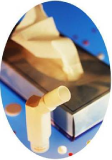 Please read this message
Please read this message
All the information contained in this section has been found on the internet. It may not be factually correct. Patient Information Leaflets (PILS) are often updated and amended. We cannot be responsible for any erroneous information unwittingly placed here. The information below is considered a basic guide only. Please ALWAYS consult qualified medical staff if you have any queries or worries about medication.
It is probably true that had we been born thirty years before we were that most of us would have been lucky to have reached 40 years old. Although there is no cure as yet we have benefited by the advances in pharmacology that happened in the last century. Just imagine life without Salbutamol (Ventolin), but this useful drug was only introduced at the end of the 1960’s.
Bronchodilators
These are drugs that allow the tiny airways (bronchioles) to open as much as possible. There are at least two different types of bronchodilator.
Beta agonists, like Salbutamol and the long acting Salmeterol relax the smooth muscle in the walls of the airways. Originally used more as ‘rescue’ treatment for asthmatics they are now a mainstay in the treatment of COPD. There are several different drugs from various companies and all are effective in treating wheeze and ‘tightness’.
Anticholergenics, like Iprotropium and Tiotropium work differently in that they suppress nerve signals that make the airways constrict. They also help reduce mucus, and are therefore widely prescribed for COPD.
Here is a good site that has more detail about Bronchodilator drugs and their side-effects.
Steroid Inhalers
One particular Professor (an Alpha-1 expert) believes that the use of a steroid inhaler is unproven, but intuitive treatment for COPD that helps reduce the damage to our lungs. Certainly there have been studies that show that inhaled steroids do help reduce the number of exacerbations and hospital admissions.
There are a number of preparations on the market. An older one is Beclomethasone, usually in a brown inhaler. A newer and more potent drug is Fluticasone, marketed as Flixatide on its own and as Seretide when combined with long acting bronchodilator Salmetarol.
The usual dose for these drugs is twice a day. Patients should not stop using them suddenly as this can produce a marked rebound effect causing severe asthma type symptoms in some people. Other side effects are a thinning of the skin, resulting in purple bruises, problems with oral candida (thrush) and in rare cases glaucoma and cataracts.
Here is a UK site that seems to be quite informative, gives advice on Inhaled Steroids.
Oral Steroids
Prednisalone tablets are usually taken in the morning. It seems the general dose appears to be 30mg/day for two weeks. These tablets help reduce the inflammation caused by a major exacerbation. They can produce a dazzling array of side effects in some people which range from psychosis to depression, weight gain and brittle bones. If you have to take them for any length of time you MUST NOT stop them suddenly as this can cause a very serious condition called adrenal insufficiency. Your Dr. will advise how you should reduce the dose over a period of weeks. As taking this drug for a long time will suppress parts of the immune system there is a risk of infection.
Disorders like shingles can reappear and must be treated seriously. Some years ago a tragedy occurred when a little girl caught chicken pox whilst being treated with oral steroids. The virus killed her. Always ask your Dr. about these tablets, and be clear when you should take them and what the dose should be.
Theophylline
These are very old drugs that were used in the 50’s to treat asthma. There is little reason to prescribe them today but some doctors still do! If you have been prescribed one of these drugs I’d seriously consider asking the Dr. if you could try life without it as it is so poisonous in overdose, and useless in underdose.
